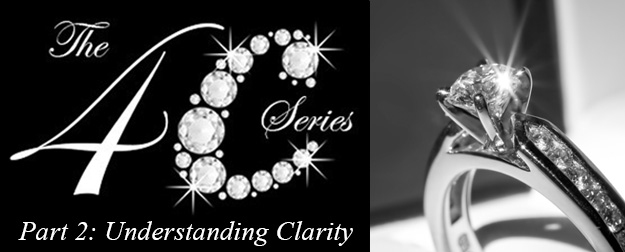What Is Diamond Clarity?
The 4C Series

Who knew there was so much to buying a diamond? Probably the last thing you have time for is to drive to a bunch of jewelry stores scattered across Phoenix, Mesa or Gilbert to learn about the different grading scales. Let us be your one-stop guide to help you make an informed decision on something that can be fairly pricey - a quality diamond. So far we’ve discussed diamond ‘color’ which had relatively easy to understand grading scale of D-Z grading (D-best quality, Z-lesser quality), but the next C – Clarity isn’t quite as simple. Let’s sidestep the possible pitfalls together.
Diamonds and Clarity
All diamonds have internal ‘inclusions’ and external ‘blemishes.’ The number, size and position of these determine clarity grade and value, in short:
- The more inclusions and blemishes a diamond has the less valuable it is
- The fewer marks a diamond has the more precious and more valuable it is
Diamond Clarity Scale
We’ve included a brief review of the clarity scale from FL- I3: FL means flawless and from there it is a range from internally flawless (IF), very, very slightly included (VVS1, VVS2) very slightly included (VS1, VS2), slightly included (SI1, SI2) and included (I1,2 or 3). In most cases, the size along with clarity needs to be considered. Here are some recommendations for clarity by carat:
- Over 2 carats = VS2 or higher to avoid any visible inclusions
- 1-2 carats = SI1 or higher will not have any inclusions visible
- Less than 1 carat = clarity isn’t as important as the other 4 C’s
Where Can I Find Diamond Clarity Information?
Because most diamond inclusions or blemishes cannot be seen by the naked eye be sure to always check the diamond grading report for the clarity grade. The industry standard for this is a GIA diamond lab report. Diamond buyer BEWARE, if you are ever told a clarity range and not a specific clarity grade then the seller is just estimating the diamond’s clarity using GIA terms and is probably not certified!
What To Look Out For When Evaluating Diamond Clarity
- Laser Drilling: This is a trick used to erase black inclusions, however, it weakens the structure of the diamond making it more likely to break. The report will state if a diamond has been drilled.
- Fracture Filling: If a fracture has occurred in a diamond sometimes it can be filled with a clear glass-like substance. GIA will not accept these types of diamonds so again, if there isn’t a certificate, walk away.
- Hidden Blemishes: Many jewelers try to hide inclusions or blemishes under the prongs of the setting. Imagine you buy a ring and it comes loose in the setting only to reveal dark spots. That would be quite an unpleasant surprise so ALWAYS ask to see the stone loose!
That covers the basics of clarity so, two ‘C’s down and two to go! If you have any questions please let us know so that we can help you understand more about the world of diamonds.
Feel free to comment below or visit us in our jewelry store showroom located in Gilbert, AZ. Stay tuned for the next in our 4C’s series where we'll give you tips on how to understand the next 'C' - diamond cut!